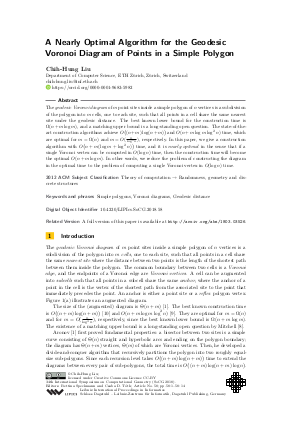A Nearly Optimal Algorithm for the Geodesic Voronoi Diagram of Points in a Simple Polygon
Author Chih-Hung Liu
-
Part of:
Volume:
34th International Symposium on Computational Geometry (SoCG 2018)
Part of: Series: Leibniz International Proceedings in Informatics (LIPIcs)
Part of: Conference: Symposium on Computational Geometry (SoCG) - License:
 Creative Commons Attribution 3.0 Unported license
Creative Commons Attribution 3.0 Unported license
- Publication Date: 2018-06-08
File

PDF
LIPIcs.SoCG.2018.58.pdf
- Filesize: 0.5 MB
- 14 pages
Document Identifiers
Subject Classification
Keywords
- Simple polygons
- Voronoi diagrams
- Geodesic distance
Metrics
- Access Statistics
-
Total Accesses (updated on a weekly basis)
0PDF Downloads0Metadata Views
Abstract
The geodesic Voronoi diagram of m point sites inside a simple polygon of n vertices is a subdivision of the polygon into m cells, one to each site, such that all points in a cell share the same nearest site under the geodesic distance. The best known lower bound for the construction time is Omega(n+m log m), and a matching upper bound is a long-standing open question. The state-of-the-art construction algorithms achieve O((n+m)log (n+m)) and O(n+m log m log^2n) time, which are optimal for m=Omega(n) and m=O(n/(log^3n)), respectively. In this paper, we give a construction algorithm with O(n+m(log m+log^2 n)) time, and it is nearly optimal in the sense that if a single Voronoi vertex can be computed in O(log n) time, then the construction time will become the optimal O(n+m log m). In other words, we reduce the problem of constructing the diagram in the optimal time to the problem of computing a single Voronoi vertex in O(log n) time.
Cite As Get BibTex
Chih-Hung Liu. A Nearly Optimal Algorithm for the Geodesic Voronoi Diagram of Points in a Simple Polygon. In 34th International Symposium on Computational Geometry (SoCG 2018). Leibniz International Proceedings in Informatics (LIPIcs), Volume 99, pp. 58:1-58:14, Schloss Dagstuhl – Leibniz-Zentrum für Informatik (2018)
https://doi.org/10.4230/LIPIcs.SoCG.2018.58
BibTex
@InProceedings{liu:LIPIcs.SoCG.2018.58,
author = {Liu, Chih-Hung},
title = {{A Nearly Optimal Algorithm for the Geodesic Voronoi Diagram of Points in a Simple Polygon}},
booktitle = {34th International Symposium on Computational Geometry (SoCG 2018)},
pages = {58:1--58:14},
series = {Leibniz International Proceedings in Informatics (LIPIcs)},
ISBN = {978-3-95977-066-8},
ISSN = {1868-8969},
year = {2018},
volume = {99},
editor = {Speckmann, Bettina and T\'{o}th, Csaba D.},
publisher = {Schloss Dagstuhl -- Leibniz-Zentrum f{\"u}r Informatik},
address = {Dagstuhl, Germany},
URL = {https://drops.dagstuhl.de/entities/document/10.4230/LIPIcs.SoCG.2018.58},
URN = {urn:nbn:de:0030-drops-87717},
doi = {10.4230/LIPIcs.SoCG.2018.58},
annote = {Keywords: Simple polygons, Voronoi diagrams, Geodesic distance}
}
Author Details
References
-
Boris Aronov. On the geodesic Voronoi diagram of point sites in a simple polygon. Algorithmica, 4(1-4):109-140, 1989.

-
Bernard Chazelle. Triangulating a simple polygon in linear time. Discrete & Computational Geometry, 6:485-524, 1991.

-
Herbert Edelsbrunner, Leonidas J. Guibas, and Jorge Stolfi. Optimal point location in a monotone subdivision. SIAM Journal on Computing, 15(2):317-340, 1986.

-
Leonidas J. Guibas and John Hershberger. Optimal shortest path queries in a simple polygon. Journal of Computer and System Sciences, 39(2):126-152, 1989.

-
Leonidas J. Guibas, John Hershberger, Daniel Leven, Micha Sharir, and Robert E. Tarjan. Linear-time algorithms for visibility and shortest path problems inside triangulated simple polygons. Algorithmica, 2(1-4):209-233, 1987.

-
John Hershberger. A new data structure for shortest path queries in a simple polygon. Information Processing Letters, 38(5):231-235, 1991.

-
Kurt Mehlhorn and Peter Sanders. Sorted sequences. In Algorithms and Data Structures: The Basic Toolbox. Springer-Verlag Berlin Heidelberg, 2008.

-
Joseph S. B. Mitchell. Geometric shortest paths and network optimization. In Handbook of Computational Geometry, pages 633-701. Elsevier, 2000.

-
Eunjin Oh and Hee-Kap Ahn. Voronoi diagrams for a moderate-sized point-set in a simple polygon. In 33rd International Symposium on Computational Geometry, SoCG 2017, July 4-7, 2017, Brisbane, Australia, pages 52:1-52:15, 2017.

-
Evanthia Papadopoulou and D. T. Lee. A new approach for the geodesic Voronoi diagram of points in a simple polygon and other restricted polygonal domains. Algorithmica, 20(4):319-352, 1998.

-
Robert Endre Tarjan. Updating a balanced search tree in O(1) rotations. Information Processing Letters, 16(5):253-257, 1983.

-
Robert Endre Tarjan. Efficient Top-Down Updating of Red-Black Trees. Technical report, Technical Report TR-006-85. Dapartment of Computer Science, Princeton University, 1985.

